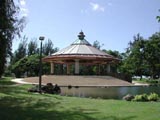




This entry is being included simply because SO MANY events were held here over the years.
Fairs, Circuses, Auto Racing, Horse Racing, Balloons, Airplanes and NO 'amusements'?
1877 - King Kalakaua dedicates Kapiolani Park as a focal point of outdoor recreation.
Although the park was initially touted to create 'a tract of land in the vicinity of Honolulu as a place of public resort,' where 'agricultural and stock exhibitions, and healthful exercise, recreations and amusements' could occur, its literal purpose was far from it.
On the dedication day in 1876, King Kalakaua and James Makee (Kapiolani Park Association's first president) stressed the public space, which they said was needed for a modern city to be civilized, to allow 'families, children, and quiet people' to find 'refreshment and recreation' in the 'kindly influences of nature,' and to be a 'place of innocent refreshment.
However, when Kapiolani Park was first conceived, the motivation wasn't about creating a public place. Kapiolani Park began as a development project, run by the Kapiolani Park Association.
The association was founded with a two-fold purpose: (1) building residences for its stockholders along the ocean at Waikiki and on the slopes of Diamond Head and (2) laying out a first-class horse-racing track as a focal point of this new suburb.
Scotsman Archibald Cleghorn, Governor of Oahu and father of Princess Kaiulani, was the park's designer. Vice-president and later president of the Kapiolani Park Association, Cleghorn planned the park's landscaping, including the ironwood trees along Kalakaua Avenue.
200 shares were sold at $50 each. (King Kalakaua was a shareholder.) Every owner received the right to lease a beachfront house lot in the park, and as a result a number of residences were built along the park's shores and around the race track during the 1880s.
The McInerny home and estate (founder of the McInerny retail stores) is where the New Otani Kaimana Beach Hotel now stands.
Samuel Northrup Castle family's three-story beachfront home 'Kainalu' became a prominent landmark in Waikīkī, as well as the landmark for the takeoff at Cal esu-f-spot. The mansion was razed in 1958 to build the Elks Club.
William Irwin’ home is where the 1927 World War I Memorial Natatorium now stands.
At the time, the park contained both arid spaces and wetlands, and the association focused on making the site usable and attractive. They soon distributed lots and established a prime racetrack complete with grandstands and stables.
All of this cost a considerable amount and the association was in debt in less than ten years. The legislature granted appropriations throughout the 1880s, and while there were some calls for transparency on the spending of public funds, the association generally slid by without much scrutiny.
The public funds did not increase public access, either, and the ocean remained blocked to the public. Later, moves were afoot to bring the public into the focus of the picture.
In 1896, an understanding was reached and later consummated between (1) the Kapiolani Park Association, which held a little over nine acres of land in fee, and a larger area on lease from the Republic, as a park, (2) William G. Irwin, who owned 19 waterfront lots and (3) the Republic of Hawaii. Irwin ended up with 18-mauka lots, known as 'Irwin Tract.'
Beginning with the deeds of July 1, 1896, Kapiolani Park was a public charitable trust, and the park commissioners were its trustees.
The Legislature of the Republic of Hawaii passed Act 53, which placed Kapiolani Park and its management to the Honolulu Park Commission, which was created specifically to manage this park.
Act 53 provided that the park was to be 'permanently set apart as a free public park and recreation ground forever.' The commission had no authority to lease or sell land in the park, a prohibition that still governs the park trust and would be key to the preservation of the park and later battles about it.
The understanding was that lands used for park use would become a free public park and that a commission formed to oversee the park had an express provision that 'The said Commission shall not have authority to lease or sell the land comprising the said park or any part thereof...'
Facing the same kinds of constraints we see today, the commission worked with budgetary constraints and labored with little public clout, but they continued to construct the park and then in 1904, first facility for the public was erected, a small aquarium.
The Territorial Legislature passed Act 103 in 1905 'to declare certain lands as public parks.' This led to the final acquisition of the oceanfront land along Kapiolani Park as the leases on the land to homeowners were allowed to expire, and in 1907, Kapiolani Park became a beach park for the first time.
In 1913, the Territory of Hawaii transferred administrative authority to the City and County of Honolulu, which still manages the park.
Later park improvements include, the Honolulu Zoo (1915) the Waikiki War Memorial Natatorium (1927) the Eastman Kodak Company was given permission to stage a Polynesian review at Sans Souci Beach (1937) the Waikiki Shell was completed and opened (1954) in 1969, the Kodak Company moved to the area adjacent to the Waikiki Shell.
Kapiolani Park's racetrack closed in 1926, but approximately half the infield area of the racetrack remained in open space.
Lots of good stuff in this post came from the Kapiolani Park Preservation Society website. This group continues to monitor and protect the public activities at Kapiolani Park.
CREDITS:Excerpts: Honolulu Library -- hookuleana.com





